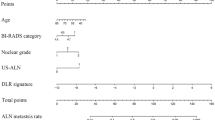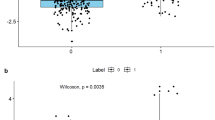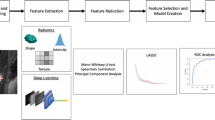Abstract
Purpose
This study aims to develop and validate a deep learning radiomics nomogram (DLRN) for prediction of axillary lymph node metastasis (ALNM) in breast cancer patients.
Materials and Methods
We retrospectively enrolled 196 patients with non-specific invasive breast cancer confirmed by pathology, radiomics and deep learning features were extracted from unenhanced and biphasic (arterial and venous phase) contrast-enhanced CT, and the non-linear support vector machine was used to construct the radiomics signature and the deep learning signature, respectively. Next, a DLRN was developed with independent predictors and evaluated the performance of models in terms of discrimination and clinical utility.
Results
Multivariate logistic regression analysis showed that the radiomics signature, deep learning signature, and clinical n stage were independent predictors. The DLRN accurately predicted ALNM and yielded an area under the receiver operator characteristic curve of 0.893 (95% confidence interval, 0.814–0.972) in the validation set, with good calibration. Decision curve analysis confirmed that the DLRN had higher clinical utility than other predictors.
Conclusions
The DLRN had good predictive value for ALNM in breast cancer patients and provide valuable information for individual treatment.






Similar content being viewed by others
Data Availability
The datasets used and/or analyzed during the current study are available from the corresponding author on reasonable request.
References
Sung H, Ferlay J, Siegel RL, Laversanne M, Soerjomataram I, Jemal A, Bray F, Global Cancer Statistics (2020) GLOBOCAN estimates of incidence and mortality worldwide for 36 cancers in 185 countries. CA Cancer J Clin 71(2021):209–249
Siegel RL, Miller KD, Fuchs HE, Jemal A (2021) Cancer Statistics. CA Cancer J Clin 71(2021):7–33
Fillon M (2022) Breast cancer recurrence risk can remain for 10 to 32 years. CA Cancer J Clin 72:197–199
Giuliano AE, Connolly JL, Edge SB, Mittendorf EA, Rugo HS, Solin LJ, Weaver DL, Winchester DJ, Hortobagyi GN (2017) Breast cancer-major changes in the American Joint Committee on Cancer Eighth Edition Cancer Staging Manual. CA Cancer J Clin 67:290–303
Noguchi M, Inokuchi M, Noguchi M, Morioka E, Ohno Y, Kurita T (2021) Axillary surgery for breast cancer: past, present, and future. Breast Cancer 28:9–15
Giuliano AE, Ballman K, McCall L, Beitsch P, Whitworth PW, Blumencranz P, Leitch AM, Saha S, Morrow M, Hunt KK (2016) Locoregional recurrence after sentinel lymph node dissection with or without axillary dissection in patients with sentinel lymph node metastases: long-term follow-up from the American College of Surgeons Oncology Group (Alliance) ACOSOG Z0011 Randomized Trial. Ann Surg 264:413–420
McGale P, Taylor C, Correa C, Cutter D, Duane F, Ewertz M, Gray R, Mannu G, Peto R, Whelan T, Wang Y, Wang Z, Darby S (2014) Effect of radiotherapy after mastectomy and axillary surgery on 10-year recurrence and 20-year breast cancer mortality: meta-analysis of individual patient data for 8135 women in 22 randomised trials. Lancet 383:2127–2135
Belmonte R, Messaggi-Sartor M, Ferrer M, Pont A, Escalada F (2018) Prospective study of shoulder strength, shoulder range of motion, and lymphedema in breast cancer patients from pre-surgery to 5 years after ALND or SLNB. Support Care Cancer 26:3277–3287
Mayerhoefer ME, Materka A, Langs G, Häggström I, Szczypiński P, Gibbs P, Cook G (2020) Introduction to radiomics. J Nucl Med 61:488–495
Dong D, Fang MJ, Tang L, Shan XH, Gao JB, Giganti F, Wang RP, Chen X, Wang XX, Palumbo D, Fu J, Li WC, Li J, Zhong LZ, De Cobelli F, Ji JF, Liu ZY, Tian J (2020) Deep learning radiomic nomogram can predict the number of lymph node metastasis in locally advanced gastric cancer: an international multicenter study. Ann Oncol 31:912–920
Ran J, Cao R, Cai J, Yu T, Zhao D, Wang Z (2021) Development and validation of a nomogram for preoperative prediction of lymph node metastasis in lung adenocarcinoma based on radiomics signature and deep learning signature. Front Oncol 11:585942
Yushkevich PA, Piven J, Hazlett HC, Smith RG, Ho S, Gee JC, Gerig G (2006) User-guided 3D active contour segmentation of anatomical structures: significantly improved efficiency and reliability. Neuroimage 31:1116–1128
van Griethuysen JJM, Fedorov A, Parmar C, Hosny A, Aucoin N, Narayan V, Beets-Tan RGH, Fillion-Robin JC, Pieper S, Aerts H (2017) Computational radiomics system to decode the radiographic phenotype. Cancer Res 77:e104–e107
Koo TK, Li MY (2016) A guideline of selecting and reporting intraclass correlation coefficients for reliability research. J Chiropr Med 15:155–163
Paul P, Pennell ML, Lemeshow S (2013) Standardizing the power of the Hosmer-Lemeshow goodness of fit test in large data sets. Stat Med 32:67–80
Zhang Z, Rousson V, Lee WC, Ferdynus C, Chen M, Qian X, Guo Y (2018) Decision curve analysis: a technical note. Ann Transl Med 6:308
Gradishar WJ, Moran MS, Abraham J, Aft R, Agnese D, Allison KH, Blair SL, Burstein HJ, Dang C, Elias AD, Giordano SH, Goetz MP, Goldstein LJ, Hurvitz SA, Isakoff SJ, Jankowitz RC, Javid SH, Krishnamurthy J, Leitch M et al (2021) NCCN Guidelines® Insights: Breast Cancer, Version 4.2021. J Natl Compr Canc Netw 19:484–493
Tausch C, Taucher S, Dubsky P, Seifert M, Reitsamer R, Kwasny W, Jakesz R, Fitzal F, Filipcic L, Fridrik M, Greil R, Gnant M (2012) Prognostic value of number of removed lymph nodes, number of involved lymph nodes, and lymph node ratio in 7502 breast cancer patients enrolled onto trials of the Austrian Breast and Colorectal Cancer Study Group (ABCSG). Ann Surg Oncol 19:1808–1817
Zong Q, Deng J, Ge W, Chen J, Xu D (2020) Establishment of simple nomograms for predicting axillary lymph node involvement in early breast cancer. Cancer Manag Res 12:2025–2035
Cheng J, Ren C, Liu G, Shui R, Zhang Y, Li J, Shao Z (2022) Development of high-resolution dedicated PET-based radiomics machine learning model to predict axillary lymph node status in early-stage breast cancer. Cancers (Basel) 14(4):950
Yu Y, He Z, Ouyang J, Tan Y, Chen Y, Gu Y, Mao L, Ren W, Wang J, Lin L, Wu Z, Liu J, Ou Q, Hu Q, Li A, Chen K, Li C, Lu N, Li X et al (2021) Magnetic resonance imaging radiomics predicts preoperative axillary lymph node metastasis to support surgical decisions and is associated with tumor microenvironment in invasive breast cancer: a machine learning, multicenter study. EBioMedicine 69:103460
Li J, Dong D, Fang M, Wang R, Tian J, Li H, Gao J (2020) Dual-energy CT-based deep learning radiomics can improve lymph node metastasis risk prediction for gastric cancer. Eur Radiol 30:2324–2333
Li K, Yao Q, Xiao J, Li M, Yang J, Hou W, Du M, Chen K, Qu Y, Li L, Li J, Wang X, Luo H, Yang J, Zhang Z, Chen W (2020) Contrast-enhanced CT radiomics for predicting lymph node metastasis in pancreatic ductal adenocarcinoma: a pilot study. Cancer Imag 20:12
Chen X, Liu W, Thai TC, Castellano T, Gunderson CC, Moore K, Mannel RS, Liu H, Zheng B, Qiu Y (2020) Developing a new radiomics-based CT image marker to detect lymph node metastasis among cervical cancer patients. Comput Methods Programs Biomed 197:105759
Yang C, Dong J, Liu Z, Guo Q, Nie Y, Huang D, Qin N, Shu J (2021) Prediction of metastasis in the axillary lymph nodes of patients with breast cancer: a radiomics method based on contrast-enhanced computed tomography. Front Oncol 11:726240
Liu Z, Ni S, Yang C, Sun W, Huang D, Su H, Shu J, Qin N (2021) Axillary lymph node metastasis prediction by contrast-enhanced computed tomography images for breast cancer patients based on deep learning. Comput Biol Med 136:104715
Yang X, Wu L, Ye W, Zhao K, Wang Y, Liu W, Li J, Li H, Liu Z, Liang C (2020) Deep learning signature based on staging CT for preoperative prediction of sentinel lymph node metastasis in breast cancer. Acad Radiol 27:1226–1233
Funding
This research was funded by Sichuan Science and Technology Program (Grant No. 2022YFS0616, 2021YFQ0002) and Applied Basic Research Program of Southwest Medical University (Grant No. 2021ZKMS048).
Author information
Authors and Affiliations
Contributions
Study design: JQ, XP. Data analysis: JQ. Data collection: YW, JQ. Drafting the manuscript: JQ, XP. Supervision of the manuscript: all authors.
Corresponding author
Ethics declarations
Ethics Approval and Consent to Participate
The study was conducted in accordance with the Declaration of Helsinki and approved by the Ethics Committee of the Affiliated Hospital of Southwest Medical University (protocol code KY2022216, 20 June 2022).
Conflict of Interest
The authors declare no competing interests.
Additional information
Publisher’s Note
Springer Nature remains neutral with regard to jurisdictional claims in published maps and institutional affiliations.
Rights and permissions
Springer Nature or its licensor (e.g. a society or other partner) holds exclusive rights to this article under a publishing agreement with the author(s) or other rightsholder(s); author self-archiving of the accepted manuscript version of this article is solely governed by the terms of such publishing agreement and applicable law.
About this article
Cite this article
Zhang, J., Yin, W., Yang, L. et al. Deep Learning Radiomics Nomogram Based on Multiphase Computed Tomography for Predicting Axillary Lymph Node Metastasis in Breast Cancer. Mol Imaging Biol 26, 90–100 (2024). https://doi.org/10.1007/s11307-023-01839-0
Received:
Revised:
Accepted:
Published:
Issue Date:
DOI: https://doi.org/10.1007/s11307-023-01839-0




